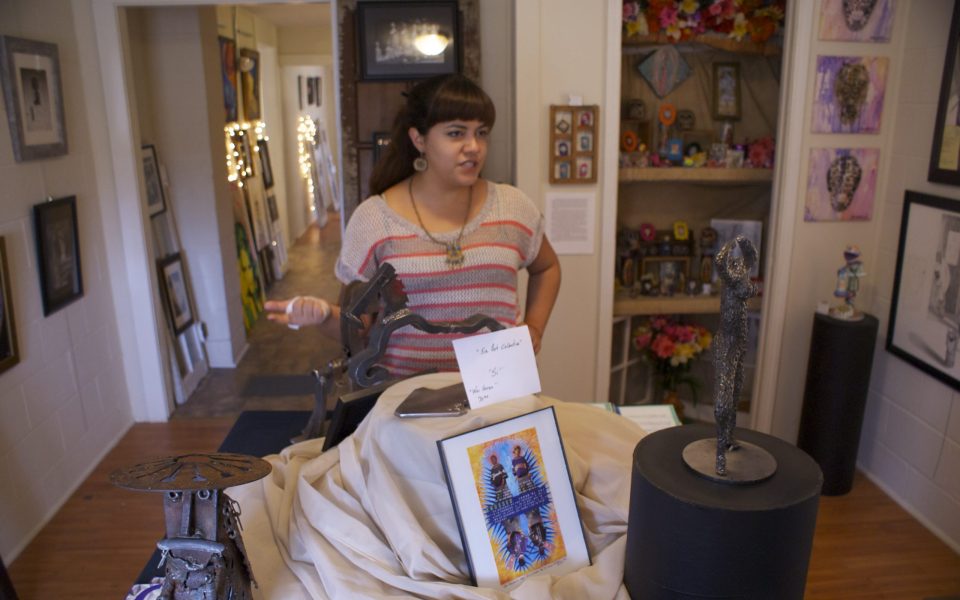by Eric Ginsburg
At the end of an informal tour of the vinyl-sided, one-story building that houses the 512 Collective, Tammy McDowell made an offhanded comment, almost an afterthought.
“You know, this is actually a reclaimed crack house,” she said, standing in the front doorway.
The High Point-based Hayden-Harman Foundation bought and transformed the Washington Street house, which looks like two shotgun apartments sewn together lengthwise. Several times former addicts have shown up on the sidewalk in front of the house, McDowell said, staring in bewilderment at the transformed residence. She’ll invite them into the artists’ space, taking them on a casual tour of the different artists’ work in various rooms, and none of them can believe they’re in the same building they once knew under such different circumstances.
McDowell and two other artists — Beka Butts and Daniel Amick — started moving the gallery and small retail operation into the building a year ago, naming their collective after the house’s street address. What they’ve created there in the shell of the former crack house quickly became the epicenter for creative activity and, they hope, an example of what is possible.
The 512 Collective has run out of space inside to display art; there are even magnets for sale on the kitchen refrigerator and pieces in one of the bathrooms. Three large rooms act as primary display areas, a fourth as a combination of storage and display and a fifth as a more retail-oriented room, though other pieces are priced, too. Metal work. Two installations including a Dia de Los Muertos shrine by Butts, who is half Mexican. Paintings, street art and jewelry.
“We try really hard to expose out-of-the-box art that people in High Point and Greensboro wouldn’t normally see,” McDowell said. “This house is ever-changing.“
It’s grown far beyond the three co-founders, which isn’t surprising given that the collective only charges $25 monthly to participate in showing. They teach art classes to elementary school kids, organize free movie screenings and are an integral part of the budding High Point Mural Project.
But McDowell almost moved away before the whole thing started rolling, and Butts wasn’t sure she wanted to jump into something based in High Point.
“I was actually out the door to go to Wilmington,” McDowell said. But creative entrepreneur Ryan Saunders convinced her to stay, leading to her involvement in the Greenhouse Collective and subsequently 512 Collective.
Butts moved back to Greensboro after attending Savannah College of Art & Design, but considered her return temporary. She hesitated to begin working with an arts effort in High Point, questioning whether it was worth the drive and whether the city was alive enough to support the endeavor.
Now instead of viewing this as a transitional time period, Butts describes it as transformational as she rediscovered Greensboro and has been rewarded for believing in High Point. Her involvement hasn’t been catalytic for only the Triad’s smallest city, though.
“I’m slowly but surely getting the Greensboro artists to come to this space,” she said.
Much of the 512 Collective’s efforts are place-based, aiming to push a revitalization of the Washington Street area. The remains of the collapsed Kilby Hotel are visible from the front of the building, which McDowell compared to a death in the family. But McDowell and Butts are quick to voice their love for existing businesses on the block as well as their hopes for an influx of public art.
“It’s a vibrant street, I just don’t think a lot of people pay attention to it,” Butts said. “We need to reinvent the city, and there’s some real talent here.”
There’s a strong contingent of people in High Point who are reluctant to change and unconventional art, but McDowell and Butts said they’ve found an undercurrent of people interested in creative solutions to High Point’s economic slump.
To that end, they see the 512 Collective as part of “building your own local economy” and empowering other artists and creative people to do the same through practical workshops and by providing a shared space.
“We show unity because it’s the only way that [the city] is going to progress,” McDowell said.
Join the First Amendment Society, a membership that goes directly to funding TCB‘s newsroom.
We believe that reporting can save the world.
The TCB First Amendment Society recognizes the vital role of a free, unfettered press with a bundling of local experiences designed to build community, and unique engagements with our newsroom that will help you understand, and shape, local journalism’s critical role in uplifting the people in our cities.
All revenue goes directly into the newsroom as reporters’ salaries and freelance commissions.


“Creative Entrepreneur?” You’ve got to be kidding. If he is, then we need less of his kind and more of the type entrepreneurs that believe in their ideas strongly enough to risk their own money on their endeavors.